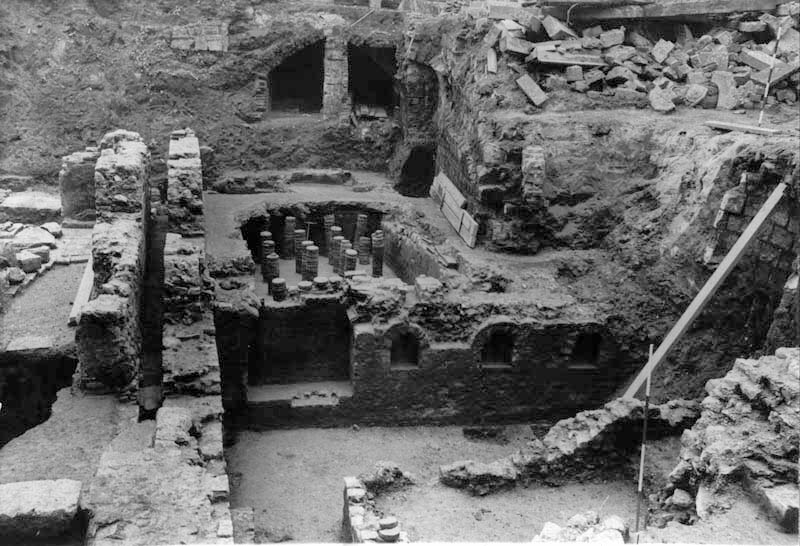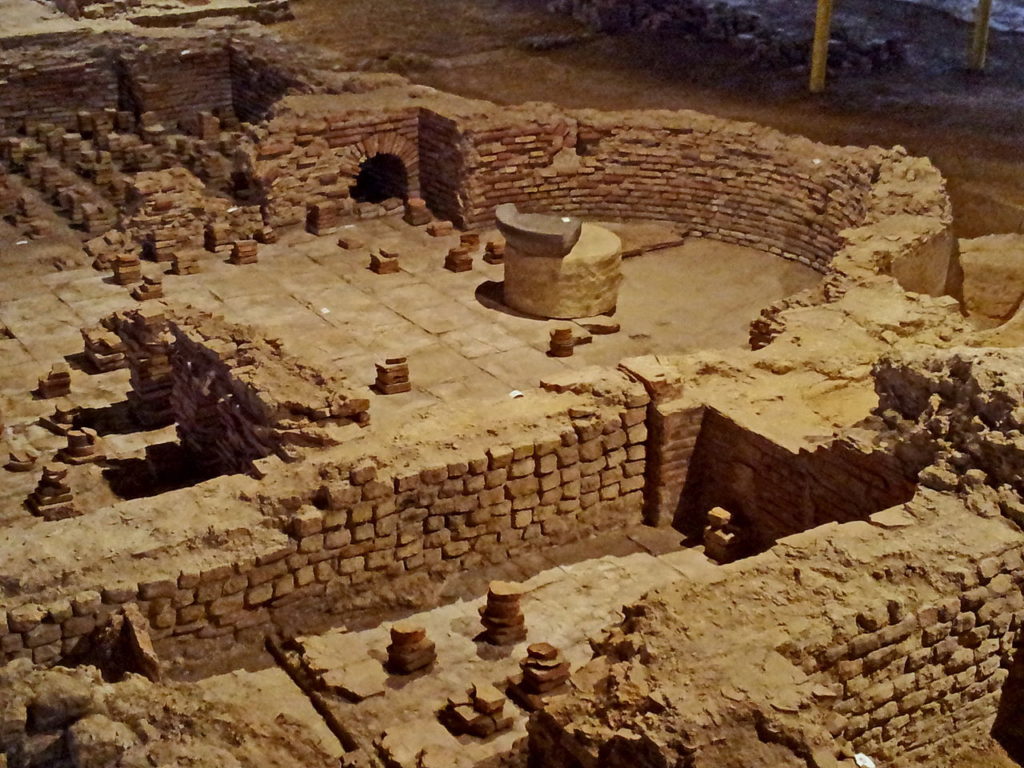The bathhouse was a part of a Roman citizen’s everyday life and was an important function of Roman society. The baths operated as facilities for physical fitness regimens, hygiene, and socializing. Even less urbanized areas of the Empire, including Traiectum ad Mosam, included bathhouses as a favorable adoption of Roman culture. It would be frequented by Patrician and Plebeian alike. As an inclusive gathering site, the news could be exchanged, business transactions carried out in a more relaxed atmosphere, and families could bond. And the bathhouse was affordable and, therefore, a non-restrictive space outside of the typical social stratification.
“I live over a public bath-house. Just imagine every kind of annoying noise! The sturdy gentleman does his exercise with lead weights; when he is working hard(or pretending to) I can hear him grunt; when he breathes out, I can hear him panting in high pitched tones. Or I might notice some lazy fellow, content with a cheap rub-down, and hear the blows of the hand slapping his shoulders. The sound varies, depending on whether the massager hits with a flat or hollow hand.To all of this, you can add the arrest of the occasional pickpocket; there’s also the racket made by the man who loves to hear his own voice in the bath or the chap who dives in with a lot of noise and splashing.”
Seneca
Letter 56.1-2
The bathhouse consisted of multiple facilities under one roof. The frigidarium supplied a cold bath, the tepidarium was for a warm bath, and the caldarium was for a hot bath. Rather than selecting one pool as a preference, it was customary to partake of all three baths over the course of the visit. The visit began with the removal of the clothes, and a sequence of exercise in the palaestra. The palaestra operated like a fitness gym and included its pool for exercise. Once the patron had completed their constitution, they would have a dip in the tepidarium. A length of time would follow this in the caldarium. This room consisted of the hot pool but also functioned very much like a steam room, where one could wade or sit in the humid heat. It was believed that the heat lifted dirt from the skin pores to the surface. Therefore, upon exiting the caldarium, an attendant, slave, or family member would rub-down the patron with perfumed olive oil and scrape the skin with a strigil to remove the dirt and exfoliate the body. The patron would then return to the tepidarium for an additional, mild soak, and then to the frigidarium for a cold dip. After this ritual of hygiene, Romans would extend their stay in the main pool where they could swim or socialize.
Sometimes a convalescing patron would skip some of the steps and go first into the caldarium. Once sweating was well underway, they would head into a plunge pool in the frigidarium to stimulate the body’s natural defenses.

From several surviving examples, the bathhouses can be described as the sort of social space designed for lingering. The baths typically had attractive designs of mosaics and marble columns. The marble flooring had radiant heat, and some were fortunate enough to tap into a natural mineral spring.
“What of their baths, contrived
Ausonius
Low down on the verge of the bank, which smoke
When Vulcan, drawn by the glowing flue, pants
Forth his flames and whirls them up through the
Channelled walls, 3 rolling in masses the imprisoned
Smoke before the scorching blast!”
The Moselle, 337
Most bathhouses did not have access to mineral water streams, yet Roman engineering allowed for the conduction of heated water regardless of the geological locale of the building. Lead pipes would carry water from its source to the bathhouse, where a massive furnace and hypocaust system heated it.

Maastricht: The grey tiles outline the site of the excavated walls of the Roman bath of Traiectum ad Mosam. (Image credit: Jona Lendering, Traiectum ad Mosam (Maastricht), CC0 1.0 Universal)
Some bathhouses incorporated restaurants or had living quarters in the upper stories. The bathhouse in Maastricht was more modest in design, with the largest Roman structure in the Netherlands being claimed by the bathhouse in Heerlen.
The foundation for the bathhouse of Maastricht was found to be intact during its excavation between 1963 and 1965. The Traiectum ad Mosam baths were built around 100 CE and were forty meters in length including its porticus. There is evidence of restoration in two phases in the 3rd and 4th Centuries. These renovations coincide with a general period of restoration and fortification of other structures within the Roman town. The baths in Traiectum ad Mosam also had an on-site food shop and changing rooms.
The square in Maastricht, which contains the reburied remains of the Roman baths, is now named Op de Thermen (“On the thermal baths”). Like other reburied Roman remains in the city, the square has dark grey pavement inset in the ground to indicate where the walls of the ruins are located, six meters below the surface.
Find out why Romans loved their bathhouses, and how they engineered heated floors and running water (in Dutch):
Visit Nearby:
Thermenmuseum (Roman Baths Museum) in Heerlen (22 km)
The remains of a Roman bath in Heerlen (Limburg, Netherlands) was discovered by a farmer in 1940. The baths are now surrounded by a museum which features artifacts collected during its excavation, and exhibitions describing the ritualization of the bathhouse in Roman society.


